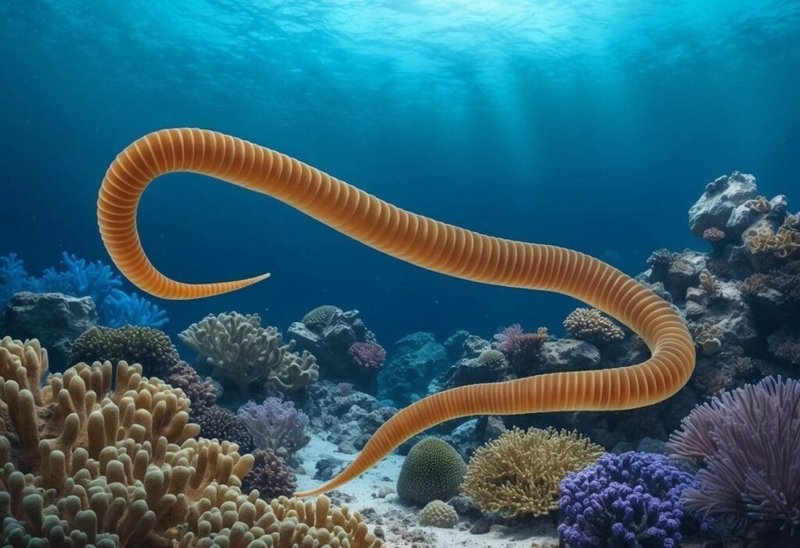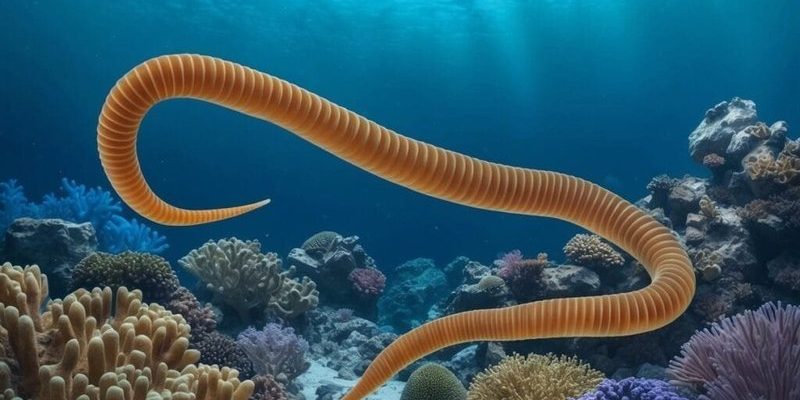
Bobbit worms belong to the family Eunice, and can grow up to three meters in length. Unlike more charismatic sea creatures, they often go unnoticed; however, their hunting skills are nothing short of impressive. In this article, we’ll dive into the evolutionary traits that make bobbit worms such effective hunters. So, grab your favorite drink and let’s explore the wonderful world of these mysterious creatures together.
1. Ambush Hunting Strategy
Bobbit worms are masters of disguise. They spend most of their lives buried deep in the sand or mud, leaving only their colorful and elongated heads exposed. This ambush hunting strategy is all about patience. They can lie in wait for hours, even days, without moving, blending seamlessly into their environment. Imagine hiding behind a bush while waiting for your favorite snack to walk by—that’s exactly what bobbit worms do.
Their ability to stay hidden is aided by their segmented bodies, which are often camouflaged to match the seafloor. This is a smart evolutionary trait because it lets them blend in with rocks, corals, and other marine life. When a fish or crustacean comes too close, the bobbit worm strikes with lightning speed, using powerful jaws to seize its meal. Honestly, it’s a bit like a surprise party for unsuspecting prey!
2. Sharp Sensory Organs
One of the secrets behind the bobbit worm’s hunting success is its incredibly sharp sensory organs. These worms have antennae and other receptors that allow them to detect vibrations in the water. Much like a spidey sense, they can sense when something is nearby, even if it’s just a faint wiggle from a curious fish.
This heightened sense of detection is critical for their ambush tactics. When they notice movement nearby, they get ready to strike. Imagine sitting in a quiet room and suddenly hearing a whisper from the other side—your alertness would kick in, right? That’s how bobbit worms react to potential food. Their evolutionary adaptations ensure they won’t miss out on a meal.
3. Strong, Powerful Jaws
Once a bobbit worm has detected its prey, it’s showtime! These worms are equipped with two large, serrated jaws that act like fearsome pincers. When it comes to evolutionary traits, these jaws are a game-changer. They can deliver a swift bite, grabbing hold of fish or shrimp before they even realize what’s happening.
The strength and speed of their jaws allow them to catch prey much larger than themselves. Think of it like a small dog managing to hold on to a much bigger one during playtime—it’s impressive! This effective hunting mechanism not only helps them secure food quickly but also minimizes the chance of escape.
4. Adaptability to Various Environments
Another factor that contributes to the bobbit worm’s success as a hunter is its adaptability. You might be wondering why that matters, but let’s break it down. Bobbit worms can thrive in different oceanic environments—whether it’s shallow reefs or deep-sea trenches. This flexibility means they can find food in a variety of conditions, increasing their chances of survival.
By adapting to different habitats, bobbit worms can also exploit various food sources. If one area is overfished or less productive, they can simply migrate to another spot. It’s like having a backup plan in case the original plan doesn’t work out. This evolutionary trait is crucial for long-term success in a rapidly changing environment.
5. Rapid Growth and Reproduction
Reproduction is an essential part of survival for any species, and bobbit worms have a unique approach here as well. They can grow quickly, reaching sexual maturity within just a few months. This rapid growth allows them to increase their population, ensuring that their hunting techniques are passed down to future generations. It’s like they’re saying, “The sooner I get to work, the better!”
By reproducing quickly, bobbit worms maintain stable numbers even in the face of predators or environmental changes. Their evolutionary strategy focuses on both survival and efficiency. The more successful hunters there are, the better chance the species has to thrive.
6. Enhanced Prey Capture Techniques
You might think that bobbit worms only rely on their jaws to capture prey, but there’s more to it! They have a unique hunting technique where they use their bodies to whip and snag prey. When they detect something nearby, they can extend their bodies and whip them around to capture food. Imagine trying to catch a butterfly with a net—it’s all about timing and precision.
This enhanced prey capture technique showcases how bobbit worms have evolved to be more than just simple burrowing creatures. They can adapt their hunting tactics based on the situation at hand. It’s a testament to their problem-solving skills in the wild.
7. Sturdy, Resilient Bodies
Finally, let’s talk about the physical resilience of bobbit worms. Their sturdy, segmented bodies provide not just strength but also the flexibility needed for quick movements. They can easily wiggle through tight spaces to escape threats or find food. Think about how a worm can slip into tiny nooks in the garden; it’s similar for bobbit worms in the ocean.
This resilience allows them to withstand various conditions, from strong currents to predatory threats. In a world where survival often comes down to physical abilities, bobbit worms have evolved bodies that are tough yet agile—making them formidable hunters.
In conclusion, bobbit worms are truly fascinating creatures with a variety of evolutionary traits that make them exceptional hunters. Their ambush strategies, sharp sensory organs, powerful jaws, adaptability, quick reproduction, enhanced capture techniques, and resilient bodies all contribute to their success in the underwater world. As we learn more about these unique worms, it becomes clear just how impressive nature can be! So, next time you think about ocean predators, remember the bobbit worm and its remarkable hunting prowess.

